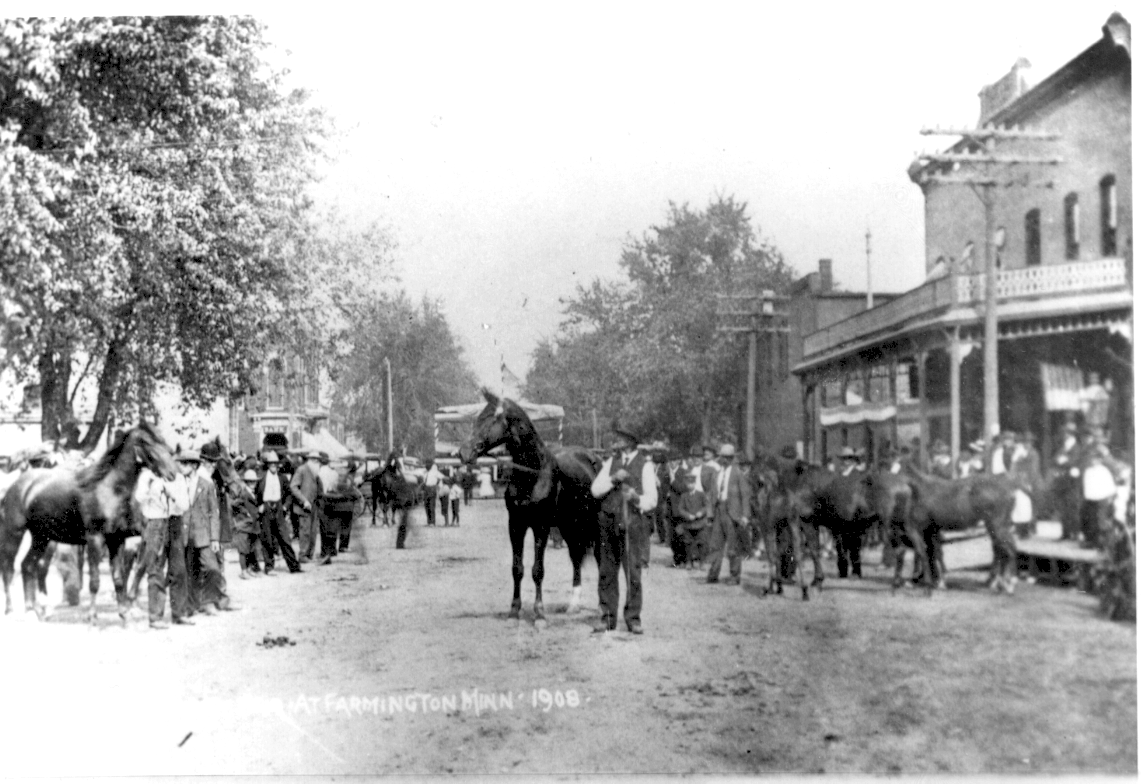
Dakota County Fair
 |
Dakota County Fair |
| Going to the Fair | |
| Farmington
History:
Local Histories: |
Farmington’s Contributions to the Dakota County Fair Imagine a summer without the county fair. Such a summer did occur. And surprisingly it happened more than once. Of all the communities in Dakota County, one has worked to insure that another summer without the county fair would never happen again. Farmington is that community. In the winter of 1858 a group of farmers and merchants met in Nininger and established an Agricultural Society, which was named after the county. The Dakota County Agricultural Society (DCAS) was organized to "promote and improve the agriculture, horticulture, mechanical, household and fine arts of Dakota County." The first fairs were held in Nininger, Hastings, and Hampton. Interest in the Agricultural Society and its fair began to decline and for five years, from 1864 to 1868, there were no county fairs. By early 1869 independent farm societies were forming throughout the county. Faced with the possibility of being replaced by an other agricultural organization, the DCAS reorganized and sent representatives to nearly every town and township throughout the county to solicit members and determine which towns would be receptive to having a permanent fairgrounds. In May 1869, Farmington was chosen to host the fair and pay for the expense of establishing fairgrounds and furnishing it with the necessary buildings. A site north of town near the Vermillion River was selected. That summer was a little brighter for all of Dakota County. Farmington saw to it that the fair was a success. So successful that in just three years, with so many exhibitors and visitors, the fairgrounds proved too small. A larger site for the fairgrounds was chosen in 1872 near Farmington in neighboring Empire Township. Twenty-five acres of the failed plat that was never built known as Dakota City were going to be sold by mortgage foreclosure. Five members of the DCAS purchased the land. The buildings, stalls and pens from the Farmington fairgrounds were moved to the new site. The fair, unfortunately, did not prosper as expected. Poor weather, small crowds, a racetrack with high expenses, and confusion about the land use arrangement – the five members expected the DCAS to pay rent for use of the fairgrounds – led to the fair’s decline. In April 1900, the five owners of the fairgrounds saw no profit in the fair and sold the property. Deep in debt and with no place to go, the DCAS turned to Farmington again as it had in 1869. For the next sixteen years Farmington closed it streets to normal traffic and business owners opened their doors to welcome the fair. Storeowners removed their merchandise from shelves to permit the display of fair exhibits. The fair, in the heart of Farmington, prospered to the point of outgrowing the available space. In 1913, Farmington businessman Alexander Empey, offered the DCAS twenty acres of land in neighboring Castle Rock Township. With Farmington’s help, the DCAS was reorganized and reincorporated in 1918. Farmington assisted the DCAS in selling stock to purchase the twenty acres. In 1920 the Dakota County Board of Commissioners purchased the fairgrounds plus and additional five acres using taxpayer money. The DCAS was now out of debt but its future was not assured. With the help of the county government, the Dakota County fair survived the difficult 1930s and 40s. County taxes were used to pay off the fair’s debts and cash advances were occasionally used to cover the fair’s expenses. Farmington continued to assist the DCAS. Members of Farmington’s American Legion helped pay for the construction of the dance pavilion – now exhibit hall number one – which produced the fair’s only income during the great depression. Prospects improved following the Second World War when the DCAS reorganized again and began to focus on youth activities. In 1977 the county commissions, using taxpayer money, purchased an additional 160 acres for the DCAS. County taxpayers continue supporting the fair. The Fair Board receives thousands of taxpayer dollars to maintain the fair. Dakota County now has one of the largest county fairgrounds in the state. The Dakota County Fair has had its full measure of growing pains and during its most difficult years Farmington was there to help it prosper and succeed. The county fair has always made Dakota County’s summers a little brighter.
|
Copyright 2001 Farmington Area Historical Society
Site design: Freestyle Solutions & Design